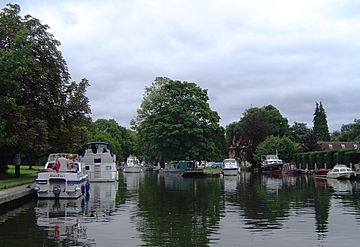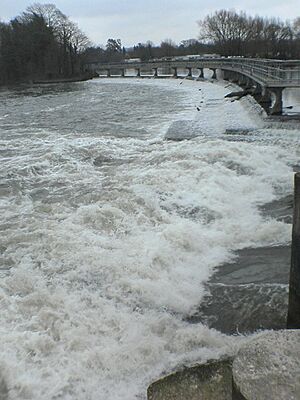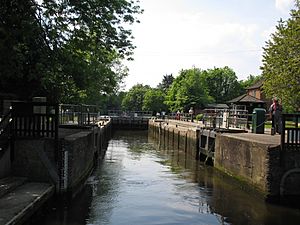Hurley Lock facts for kids

Hurley Lock and islands from upstream
|
|
| Waterway | River Thames |
|---|---|
| County | Berkshire |
| Maintained by | Environment Agency |
| Operation | Hydraulic |
| First built | 1773 |
| Latest built | 1785 |
| Length | 39.82 m (130 ft 8 in) |
| Width | 6.07 m (19 ft 11 in) |
| Fall | 1.05 m (3 ft 5 in) |
| Above sea level | 96' |
| Distance to Teddington Lock |
40 miles |
Hurley Lock is a special water gate, called a lock, and a small dam, known as a weir. They are located on the River Thames in England. You can find them among some wooded islands near the village of Hurley, Berkshire. The lock was first built a long time ago in 1773.
There are a few weirs between the islands. The main weir is further upstream, between the biggest island and the Buckinghamshire river bank. This weir is a popular spot for kayakers. They love to visit when the water conditions are just right, especially on weekends.
Contents
History of Hurley Lock
A very old type of lock, called a Flash lock, used to be here. People in the 1500s and 1600s called it "New Lock." The modern type of lock, known as a pound lock, opened in 1773. It was one of the first eight locks built after a special law was passed in 1770 to improve river travel.
The first lock was made of fir wood. Like other locks built then, it needed repairs often because the wood decayed. It was fixed in 1780 and again in 1785. The old timber winch, which looks like a large spinning post and was used to pull boats through the flash lock, is still at Hurley Lock today. The lock has since been rebuilt with strong stone.
Visiting Hurley Lock
It's easy to get to the lock and weir. You can take a short path from a free car park. This car park is at the end of Hurley High Street in the village of Hurley. The village is on the south side of the river.
River Journey Above the Lock
A little way upstream on the Buckinghamshire bank, you'll find Medmenham Abbey. The river then winds through open countryside. You'll see two islands, Frog Mill Ait and Black Boy Island, on a sharp bend. Further along, Magpie Island is near Culham Court, on the way to Hambleden and Hambleden Lock.
The Thames Path Trail
The Thames Path walking trail stays on the Berkshire side of the river. It goes away from the river for a bit, leading to the village of Aston, Berkshire. Then, it returns to the river and continues towards Hambledon Lock.
Kayaking at Hurley Weir
Hurley is a very active place for freestyle kayaking. This is because the wave created by the weir is a great size and shape. The open gates of the weir create a special "standing wave" that kayakers love. Hurley also hosts an annual kayaking competition called the Hurley Classic.
Getting to the Kayaking Spot
There are two paths from the car park that lead to the river. Kayakers can start their journey on a flat part of the river right when they arrive from the car park. To reach the main wave, they need to paddle upstream (to the left). The weir will then appear on their right.
It's best to avoid the first weir you see, as it's not safe for kayaking. While Hurley Weir's steps can be used, they might damage the bottom of a kayak. It's smarter to get out at the island where the weir steps begin and then put your kayak back in the water at the shingle "beach" below.
How the Weir Gates Affect Kayaking
The four main gates of the weir are opened and closed to control the river's water levels. The number of open gates also changes the type of wave, making it easier or harder for kayakers:
- 1 Gate: This creates a medium-sized wave, usually on the right side of the weir. It's best for longer, faster kayaks.
- 2 Gates: This makes a big wave with a large "hole" (a foamy, swirling area) behind it.
- 3 Gates: This is often the best level for kayaking. When three gates are open on the left side, it creates a big wave in the middle with two holes on either side. This perfect condition doesn't last long, and during busy times, there can be long queues of kayakers.
- 4 Gates: This creates a powerful set of connected holes. The hole furthest from the calm water (called the "eddy") is sometimes called "The Dark Side." It's still fairly safe, but it can hold kayaks in place at certain water levels. If you capsize here, you'll usually be washed downstream quickly.
Sometimes, the wave train moves to the left, making the calm eddy water spin. This can push kayakers waiting in the eddy into the main current.
Understanding Water Levels
More rainfall usually means more gates will be open. However, this also depends on the water levels at weirs further upstream. So, it can be tricky to guess exactly what the conditions will be like.
For the weir to form a good wave for kayakers, it usually needs to be late autumn, winter, or early spring. Hurley is known to have good kayaking conditions in the summer too, but only for short periods. On average, it's good for about nine months of the year. In winter, a general rule is that about 10 millimeters (0.4 inches) of rain is needed to open one gate. In summer, it might need 15 millimeters (0.6 inches) of rain, and steady rain is needed to keep the levels up because the ground is drier.
Hurley Lock in Books
Jerome K Jerome, a famous writer, once wrote about Hurley Lock. He said he often thought I could stay a month without having sufficient time to drink in all the beauty of the scene.







